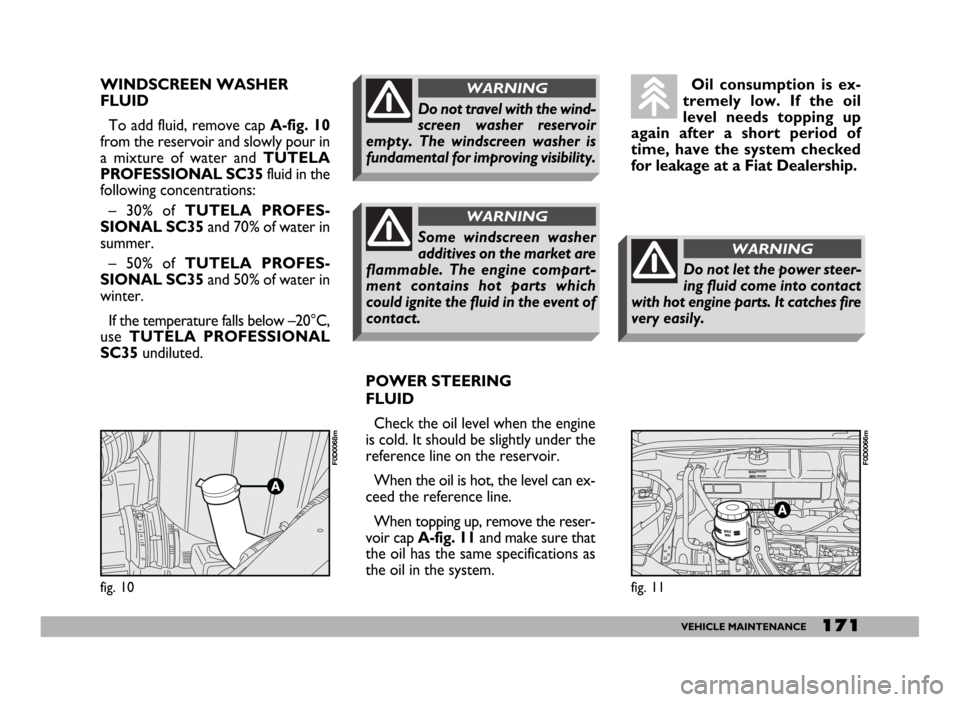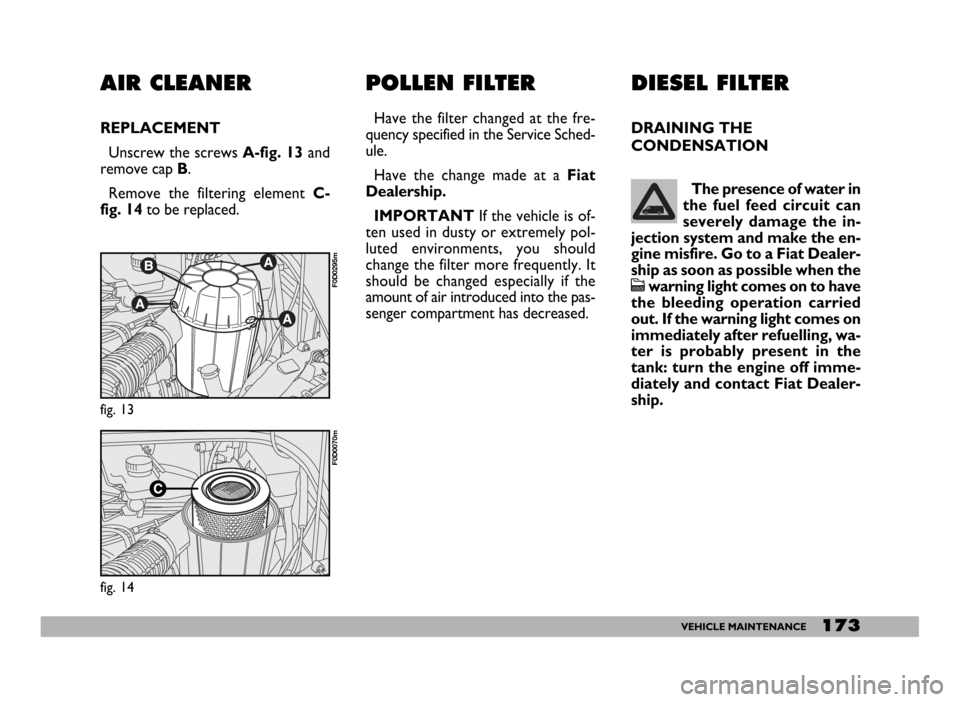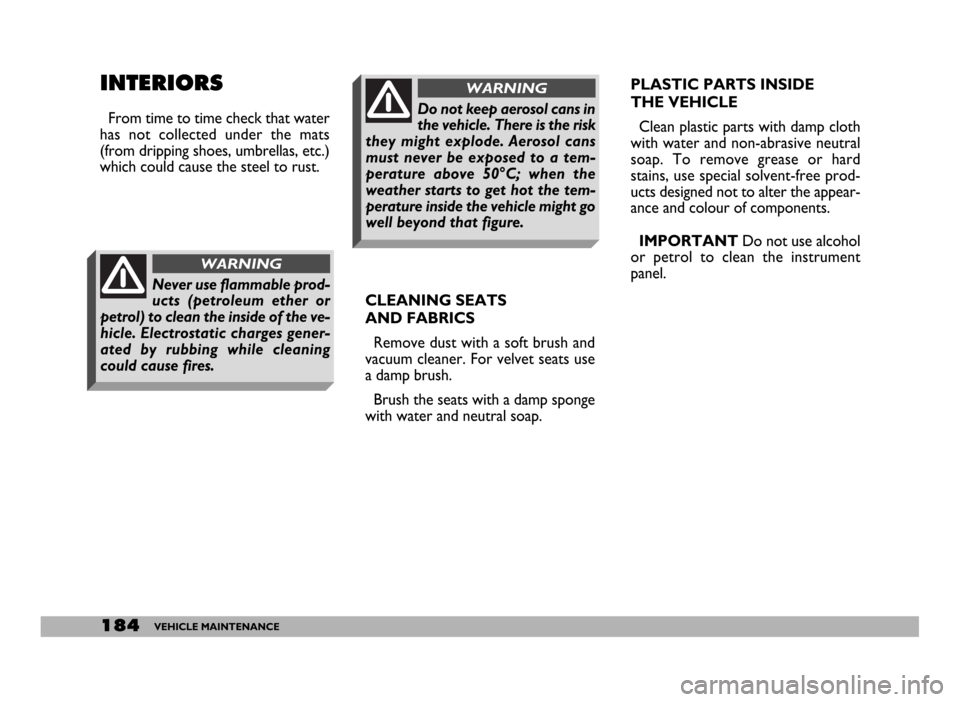2005 FIAT DUCATO 244 water
[x] Cancel search: waterPage 166 of 258

165VEHICLE MAINTENANCE
ANNUAL
INSPECTION
SCHEDULE
The following annual inspection
schedule is required for vehicles trav-
elling 15,000 Kmapprox. a year. The
schedule includes the following oper-
ations:
– check tyre condition and wear and
adjust pressure, if required (including
spare wheel);
– check operation of lights (head-
lights, direction indicators, hazard
lights, boot light, passenger compart-
ment light, instrument panel lights,
etc.);
– check windscreen wiper/washer
and adjust nozzles;
– check position and wear of wind-
screen/rear window wiper blades;
– check front pad conditions and
wear;
– check for bonnet and boot lock
cleanness, lever cleanness and lubri-
cation;– inspect conditions of: engine, gear-
box, transmission, piping (exhaust, fu-
el feed, brakes), rubber parts (boots,
sleeves, bushings, etc.), brake and fu-
el line hoses;
– check battery charge status;
– check conditions of various control
belts;
– check and top up fluid levels (en-
gine coolant, brakes, windscreen
washer, battery, etc.);
– check and top up engine oil;
– replace pollen filter.
ADDITIONAL
CHECKS
Every 1,000 km or before long
trips, check and top up as necessary:
– engine coolant level
– brake fluid level
– power steering fluid level
– battery electrolyte level
– windscreen washer fluid
– tyre pressure and conditions.
Every 3,000 km or before long
trips, check and top up as necessary:
engine oil
Every 10,000 kmor at cwarning
light coming on (diesel engines only):
bleed water from fuel filter.
You are recommended to use FL
Seleniaproducts designed and pro-
duced for Fiat vehicles (see the “Ca-
pacities” table in the “Technical Spec-
ifications” section).
Page 172 of 258

171VEHICLE MAINTENANCE
WINDSCREEN WASHER
FLUID
To add fluid, remove cap A-fig. 10
from the reservoir and slowly pour in
a mixture of water and TUTELA
PROFESSIONAL SC35fluid in the
following concentrations:
– 30% ofTUTELA PROFES-
SIONAL SC35and 70% of water in
summer.
– 50% ofTUTELA PROFES-
SIONAL SC35and 50% of water in
winter.
If the temperature falls below –20°C,
useTUTELA PROFESSIONAL
SC35undiluted.
POWER STEERING
FLUID
Check the oil level when the engine
is cold. It should be slightly under the
reference line on the reservoir.
When the oil is hot, the level can ex-
ceed the reference line.
When topping up, remove the reser-
voir cap A-fig. 11 and make sure that
the oil has the same specifications as
the oil in the system.Oil consumption is ex-
tremely low. If the oil
level needs topping up
again after a short period of
time, have the system checked
for leakage at a Fiat Dealership.
fig. 10
F0D0068m
fig. 11
F0D0066m
Do not let the power steer-
ing fluid come into contact
with hot engine parts. It catches fire
very easily.
WARNINGSome windscreen washer
additives on the market are
flammable. The engine compart-
ment contains hot parts which
could ignite the fluid in the event of
contact.
WARNING
Do not travel with the wind-
screen washer reservoir
empty. The windscreen washer is
fundamental for improving visibility.
WARNING
Page 173 of 258

172VEHICLE MAINTENANCE
BRAKE FLUID
Loosen plug A-fig. 12and check
that the level of the fluid in the reser-
voir is at the maximum
Check at regular intervals that the
level of the fluid in the reservoir is at
the maximum.
Use only DOT 4 fluid only for top-
ping up. We recommend TUTELA
TOP 4that the braking system was
originally filled with.
IMPORTANTBrake fluid is hy-
groscopic (meaning it absorbs humid-
ity). This is why the fluid should be
changed more frequently than shown
in the Service Schedule if the vehicle
is mainly driven in areas with a high
percentage of humidity in the air. Make sure that the
highly corrosive brake
fluid does not drip onto
the paintwork. If it does, wash it
off immediately with water.
fig. 12
F0D0067m
The symbol πon the con-
tainer indicates synthetic
brake fluid distinguishing it from
mineral fluid. Using mineral type
fluid would damage the special rub-
ber braking system gaskets beyond
repair.
WARNING
Brake fluid is poisonous
and very corrosive. In the
event of accidental contact, wash
the affected part with water and
mild soap and rinse. If the fluid is
swallowed, call a doctor immedi-
ately.
WARNING
Page 174 of 258

173VEHICLE MAINTENANCE
AIR CLEANER
REPLACEMENT
Unscrew the screws A-fig. 13and
remove cap B.
Remove the filtering element C-
fig. 14to be replaced.
fig. 13
F0D0295m
fig. 14
F0D0070m
POLLEN FILTER
Have the filter changed at the fre-
quency specified in the Service Sched-
ule.
Have the change made at a Fiat
Dealership.
IMPORTANTIf the vehicle is of-
ten used in dusty or extremely pol-
luted environments, you should
change the filter more frequently. It
should be changed especially if the
amount of air introduced into the pas-
senger compartment has decreased.
DIESEL FILTER
DRAINING THE
CONDENSATION
The presence of water in
the fuel feed circuit can
severely damage the in-
jection system and make the en-
gine misfire. Go to a Fiat Dealer-
ship as soon as possible when the
cwarning light comes on to have
the bleeding operation carried
out. If the warning light comes on
immediately after refuelling, wa-
ter is probably present in the
tank: turn the engine off imme-
diately and contact Fiat Dealer-
ship.
Page 175 of 258

174VEHICLE MAINTENANCE
REPLACING THE BATTERY
If required, replace the battery with
a genuine spare part presenting the
same specifications. If a battery with
different specifications is fitted, the fre-
quencies shown in the “Service Sched-
ule” will no longer be valid. Refer to
the instructions provided by the bat-
tery manufacturer.
Batteries contain sub-
stances that are very
harmful for the environ-
ment. You are advised to have the
battery changed at a Fiat Dealer-
ship. It is properly equipped for
disposing of used batteries in an
environmentally-friendly way that
complies with the law.
Incorrect fitting of elec-
trical and electronic ac-
cessories can seriously
damage the vehicle. If you want
to add accessories after buying
the vehicle antitheft system, ra-
dio, free-hand phone kit, etc.) vis-
it a Fiat Dealership. They can sug-
gest the most suitable acces-
sories to get and check whether
the electric system can support
the required load or whether a
higher capacity battery is re-
quired.
The liquid in the battery is
poisonous and corrosive.
Do not let it touch the skin or eyes.
Do not bring naked flames or pos-
sible sources or sparks near the bat-
tery: risk of fire and explosion.
WARNING
fig. 15
F0D0244m
BATTERY
Fiat Ducato battery is of the “Limit-
ed maintenance” and is fitted with in-
dicator A-fig. 15to check the elec-
trolyte level and the charge.
Under normal conditions of use it
does not require topping up with dis-
tilled water. However, check it peri-
odically through the control optical in-
dicator that is placed on the battery
cover and must be dark with a cen-
tral green area.
If the indicator is a bright colour, or
dark without the green central area,
contact a Fiat Dealership.
Page 183 of 258

182VEHICLE MAINTENANCE
– the use of zinc-plated sheet steel
which is highly resistant to rust;
– the spraying of the underbody, en-
gine compartment, inside the wheel-
houses and other parts with wax-
based products with a high protective
capacity;
– spraying plastic-coating materials
to protect the most exposed points:
under the door, inside the wings, the
edges, etc.;
– the use of “open” box sections to
prevent condensation and water from
building up and rusting the inside of
the parts.
BODY AND UNDERBODY
WARRANTY
Your Ducato is covered by warranty
against any original structural or body
part being perforated by rust. Refer to
the Warranty Booklet for the general
terms.TIPS FOR KEEPING THE BODY
IN GOOD CONDITIONS
Paintwork
The paintwork is not only to make
your vehicle look attractive but also
to protect the steel.
If the paint is scuffed or scratched
deeply you are therefore advised to
touch up as necessary to prevent rust
from forming.
Only use genuine products when
touching up the paintwork (see sec-
tion “Technical Specifications”).
Ordinary maintenance of the paint-
work means washing it. The frequency
you should do this depends on the
conditions and the environment the
vehicle is driven in.
For example:
– areas with a high level of air-pollu-
tion;
– roads sprinkled with road saltwash;
– parking under trees which drop
resin. In these cases, wash your vehi-
cle more frequently.To wash the vehicle properly:
1)wash the body using a low pres-
sure jet of water;
2) wipe a sponge with a slightly
soapy solution over the bodywork,
frequently rinsing the sponge;
3) rinse well with water and dry
with a jet of air or a chamois leather.
When drying the vehicle, be careful
to get at those parts which are not so
easily seen, e.g. the door frames, bon-
net and around the headlights where
water can most readily collect. You
should leave the vehicle out in the
open so that any water remaining can
evaporate more easily.
Page 185 of 258

184VEHICLE MAINTENANCE
INTERIORS
From time to time check that water
has not collected under the mats
(from dripping shoes, umbrellas, etc.)
which could cause the steel to rust.
CLEANING SEATS
AND FABRICS
Remove dust with a soft brush and
vacuum cleaner. For velvet seats use
a damp brush.
Brush the seats with a damp sponge
with water and neutral soap.PLASTIC PARTS INSIDE
THE VEHICLE
Clean plastic parts with damp cloth
with water and non-abrasive neutral
soap. To remove grease or hard
stains, use special solvent-free prod-
ucts designed not to alter the appear-
ance and colour of components.
IMPORTANTDo not use alcohol
or petrol to clean the instrument
panel.
Never use flammable prod-
ucts (petroleum ether or
petrol) to clean the inside of the ve-
hicle. Electrostatic charges gener-
ated by rubbing while cleaning
could cause fires.
WARNING
Do not keep aerosol cans in
the vehicle. There is the risk
they might explode. Aerosol cans
must never be exposed to a tem-
perature above 50°C; when the
weather starts to get hot the tem-
perature inside the vehicle might go
well beyond that figure.
WARNING
Page 217 of 258

216TECHNICAL SPECIFICATIONS
BRAKES
SERVICE AND EMERGENCY
BRAKES
Front: disc, floating caliper with two
operating cylinders for each wheel and
pad wear warning light.
Rear: self-centring shoes and micro-
metric mechanism for clearance take-
up.
Certain versions are fitted with rear
disc brakes with Drum in hat device
(i.e. drum on disc to block the vehicle
when parked with handbrake en-
gaged).
Cross-over hydraulic circuit control.
Four sensors ABS system with EBD.
Automatic recovery of the friction
gasket wear; versions with rear disc
brake excluded (Drum in hat ver-
sions).
Lacking ABS system brakeforce dis-
tributor acting on rear brake hydraulic
circuit according to rear axle load.HANDBRAKE
Controlled by a lever, it works me-
chanically on the rear brake shoes.
For versions with rear disc brakes,
the handbrake works on the Drum in
hat device shoes.
IMPORTANTPull the handbrake
lever only when the vehicle is at a
standstill, or when the vehicle is run-
ning, but however only in case of a
failure of the hydraulic system.
Should the handbrake be exception-
ally used when the vehicle is running,
it is suggested to keep a moderate
traction to avoid causing the rear axle
block, entailing vehicle side skidding.
TRANSMISSION
CLUTCH
Hydraulically controlled without
travel-free pedal.
MECHANICAL GEARBOX
AND DIFFERENTIAL
Five forward gears and reverse with
synchromesh for front gear engage-
ment.
Cyclical gear reduction and differen-
tial assembly incorporated in the gear-
box.
Drive transmission to the front
wheels by means of drive shafts con-
nected to the differential assembly and
the wheels with CV joints.
Water, ice or salt on road
surfaces can deposit on
brake discs, reducing braking effi-
ciency on the first braking.
WARNING